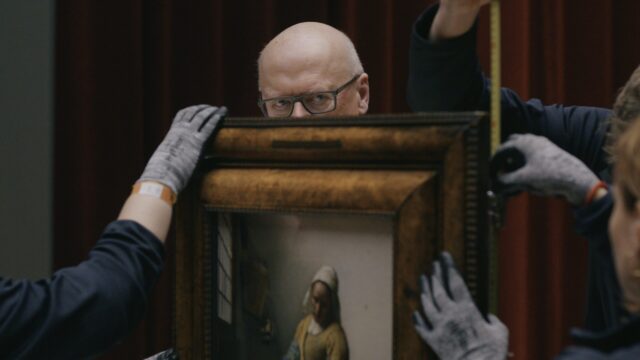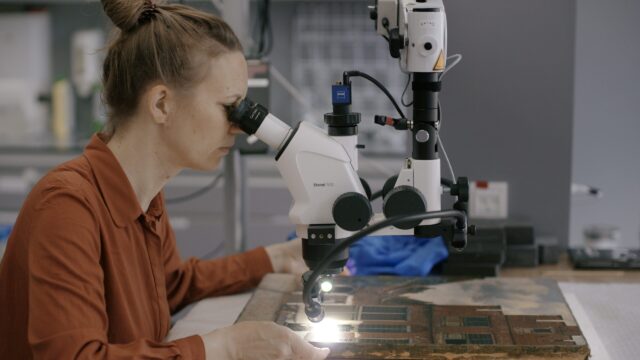
Curator Gregor J. M. Weber studies Vermeer’s The Milkmaid in stunning new documentary
CLOSE TO VERMEER (Suzanne Raes, 2023)
Quad Cinema
34 West 13th St. between Fifth & Sixth Aves.
Through August 3
212-255-2243
quadcinema.com
The first painting I ever fell in love with was Johannes Vermeer’s The Milkmaid. At the time, I knew nothing about it, other than it was this beguiling framed picture in my maternal grandparents’ Brooklyn apartment and, later, one-story home on a canal in a retirement community in Fort Lauderdale. I was still in single digits, so I didn’t understand the concept of a print or a poster; I thought it was the actual painting itself, a fascinating depiction of a woman casually dripping milk from a pitcher into a two-handled bowl on a table with a basket of bread, behind her a bare, somewhat dirty wall.
When I saw the real deal at the Met in 2009, on loan from the Rijksmuseum in Amsterdam, it was joined by all five of the Met’s Vermeers. Seeing The Milkmaid in person left me breathless, sending me back to those days driving down to Florida with my family for our annual February visit; my grandparents and parents are no longer with us, but The Milkmaid is, most recently on view in the internationally hailed Rijksmuseum exhibition simply titled “Vermeer,” consisting of the most Vermeers ever gathered at one venue, twenty-eight of the Dutch artist’s thirty-seven extant works.
Suzanne Raes’s thrilling documentary, Close to Vermeer, goes behind the scenes of the exhibition, following curators, researchers, gallerists, collectors, and conservators as the show comes together, complete with exciting controversies and several big bumps in the road.
“The moment I saw the Vermeers I actually fainted,” exhibition curator Dr. Gregor J. M. Weber says about the first time he experienced Vermeer’s Lady Standing at a Virginal and Lady Seated at a Virginal as a schoolboy on a trip to the National Gallery in London. “The best exhibitions I’ve ever seen didn’t just determine my life during the two hours I was there . . .” He trails off, having to compose himself as he is nearly brought to tears. “A good exhibition should sweep you away. It should change the way you look. Your view of the world changes. As you’re drawn into this other world, and you’re almost floating. Vermeer can really do that.” So can an outstanding documentary.
“What is this mysterious object that I’ve just seen? It looks like it came from Mars and landed down and wanted to say something to me,” painter and Vermeer expert Jonathan Janson remembers upon seeing a photograph of his first Vermeer. He later cannot hold back tears when he sees what he thinks will be the last Vermeer he’ll encounter for the first time: Never again will he have that moment of discovery.

Conservator and researcher Anna Krekeler takes a close look at Vermeer’s The Little Street in Close to Vermeer
The documentary is structured around curators Weber and Pieter Roelofs’s travels to institutions to try to convince them to lend their Vermeers to the exhibit. The Rijksmuseum has four Vermeers; the determined men, individually or as a dynamic duo, head to the Metropolitan Museum of Art in New York City to ask curator Adam Eaker about its five holdings; encounter resistance from curator Silke Gatenbröcker about the Herzog Anton Ulrich Museum in Braunschweig’s one Vermeer, The Girl with a Wineglass; check out the Mauritshuis at The Hague’s three Vermeers, including The Girl with a Pearl Earring, with conservator and researcher Abbie Vandivere, who is so obsessed with the painting that she dyes her dreadlocks Vermeer blue; glory in the three Vermeers at Frick Madison with Frick Collection chief curator Xavier F. Salomon; and battle with curators Betsy Wieseman and Alexandra Libby of the National Gallery in DC over one of its four Vermeers, Girl with a Flute, debating whether it is indeed a legitimate Vermeer or was painted by someone else.
We also hear from research scientist Annelies van Loon, Rijksmuseum general director Taco Dibbits, research conservator Melanie Gifford, and others as they seek to find out more about Vermeer’s process and delve into how the exhibition will be laid out to provide maximum engagement for the expected huge crowds.
The joy these people feel when seeing and studying the paintings is like that of children receiving Christmas presents. “I want to understand how he was able to paint these wonderful pictures,” conservator and researcher Anna Krekeler says, examining The Little Street through a microscope. “Take this red shutter, possibly the most beautiful shutter in the history of art. If you imagine this painting without the red shutter, it’s much less . . . captivating. The red shutter stops you from leaving the painting here, so you keep looking.”
When curator of drawings Maud van Suylen provides evidence that supports Weber’s theory that Vermeer used a camera obscura, which Weber has explored with his partner, Lisanne Wepler, it is like he has uncovered the Holy Grail. One Holy Grail that is not uncovered is any significant new biographical information about Vermeer, who died in December 1675 at the age of forty-three. He had fourteen children but left behind no letters or diaries, and never painted a self-portrait. It is believed that it is his back we see in The Allegory of Painting. “All we have are his paintings,” Weber says.
In her director’s statement, Raes (Two Men, Ganz: How I Lost My Beetle) explains, “Even more than to Rembrandt’s characters or Jan Steen’s debauched scenes, I am drawn to Vermeer’s paintings. The stilled movements and characters he portrayed make you, the viewer, a witness to what was once everyday life. You are close to these people, the room with the large window to the left, the filtered light, the carefully arranged scene. Sometimes the person portrayed is deeply absorbed in reading a letter, pouring milk, looking through a telescope. In the few instances she looks straight at you, she sees straight into your soul.” Raes captures those feelings in her film, which is beautifully photographed by Victor Horstink and edited by Noud Holtman, with lovely music by Alex Simu.
After watching the film, I went to the Met to see A Maid Asleep, Young Woman with a Water Pitcher, Woman with a Lute, Allegory of the Catholic Faith, and Study of a Young Woman, the five works the museum is not allowed to ever lend out. The documentary helped “change the way I look” at paintings, to echo Weber’s words about what a good exhibition should do.
“It’s about the story we want to tell, not the number of paintings,” Weber says as he realizes that the show will go on without every work he hoped would be in the show. He also reveals that this will be the final exhibition he will curate. “This will be my crowning achievement.”
It’s quite an achievement, splendidly illuminated in this engrossing and involving film that, at its heart, is a celebration of the power of great art and how it portrays the human condition.